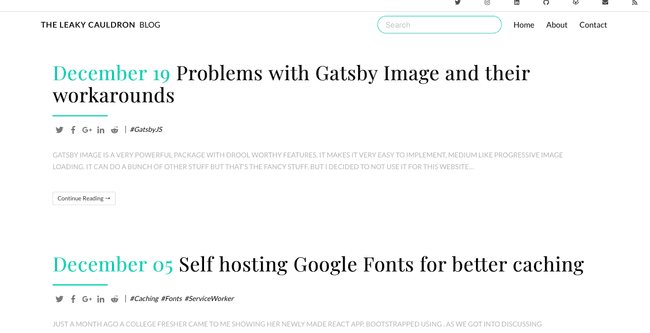Problems with 'gatsby-image' and their workarounds

gatsby-image is a very powerful package with drool-worthy features. It makes it very easy to implement, Medium like progressive image loading. It can do a bunch of other stuff but that’s the fancy stuff that we won’t be going into. But I decided to not use it for this website, mostly because it doesn’t play well with Netlify CMS. And, I was quite happy with the site’s performance as it didn’t have many images.
The article list was all words, no thumbnails and since all the images were within the article, it worked just fine.
This all changed when I decided to ditch Bulma for Tachyons.
With New Framework Comes New Design
- Anonymous (Probably LOL)
In the new design, I was working the article list had a small thumbnail along with the title and excerpt.
Without the optimisation magic of gatsby-image each page size would be touching 5MB. Begrudgingly, I decided to use gatsby-image. I did what anyone would do, installed the package and peer dependencies. And as instructed added the relevant config. That’s when the problem began! Everything started breaking. And I’m ashamed that it took me a lot more time than I’m willing to admit, to solve them. Well everyone has bad days.
Things to be careful about while configuring gatsby-image
First, you need gatsby-remark-relative-images to convert image src(s) in markdown to be relative to their node’s parent directory. So that gatsby-remark-images can match images outside the node folder. This is especially important if you are working with Netlify CMS. Also, don’t forget to add fmImagesToRelative to gatsby-node.js.
const {fmImagesToRelative} = require('gatsby-remark-relative-images')
exports.onCreateNode = ({node, actions, getNode}) => {
const {createNodeField} = actions
fmImagesToRelative(node)
if (node.internal.type === `MarkdownRemark`) {
const value = createFilePath({node, getNode})
createNodeField({
name: `slug`,
node,
value,
})
}
}Second, The ’gatsby-source-filesystem’ media folder must be included before the other plugins, especially Netlfiy CMS. That’s something that has been mentioned in gatsby-transformer-remark’s README.md. Not only that, it’ll be best if you include ’gatsby-transformer-sharp’ ’gatsby-plugin-sharp’ and ’gatsby-transformer-remark’ before any other plugin in gatsby-config.js. Not doing this might lead to the following error.
Field "image" must not have a selection since type "String" has no subfieldsThird, once you are done configuring you cannot just query an image without parameters. I suggest publicURL.
Fourth, GIFs and SVGs are not processed by gatsby-image. So always include publicURL in the parameters as an alternate.
export const imageQuery = graphql`
image {
childImageSharp {
fluid(maxWidth: 1075, quality: 72) {
...GatsbyImageSharpFluid
}
}
publicURL
}` {!!image && !!image.childImageSharp
? <Img fluid={image.childImageSharp.fluid}
alt={title}
/>
: <img src={image.publicURL}
alt={title}
/>
}Finally, sometimes the build can fail just because node_modules/ needs to be rebuilt. So, if you see nothing else working try removing node_modules/ and reinstalling packages.
gatsby-image and gatsby-paginate don’t go well together
While implementing Article List I ran into an error that disturbed me for hours. Let me preface by explaining how gatsby-paginate works. We plugin Gatsby Paginate’s createPaginatedPages function in gatsby-node.js. It takes the createPages method and takes results of the query to create a paginated list of posts.
return graphql(`
{
allMarkdownRemark(sort: { order: DESC, fields: [frontmatter___date] }) {
edges {
node {
excerpt(pruneLength: 250)
id
fields {
slug
}
frontmatter {
title
tags
date(formatString: "MMMM DD, YYYY")
templateKey
}
}
}
}
}
`)So, if I had to display a thumbnail on my article list I just add that query. Simple enough right? Wrong! You add an image to the query, and you run into the first problem, it needs to have parameters. That’s okay, you need to apply ...GatsbyImageSharpFluid anyways, but wait! This throws an error, one that drove me crazy and made me write this article.
return graphql(`
{
allMarkdownRemark(sort: { order: DESC, fields: [frontmatter___date] }) {
edges {
node {
excerpt(pruneLength: 250)
id
fields {
slug
}
frontmatter {
image
title
tags
date(formatString: "MMMM DD, YYYY")
templateKey
}
}
}
}
}
`)Error: unknown fragment ...GatsbyImageSharpFluidThis is an annoying problem because the reason it states is very confusing! GatsbyImageSharpFluid is a fragment and I know that for sure. After searching for hours I find out an interesting thing.
The query in gatsby-node.js is only the path and stuff you put in context, which you can use in your page/template to retrieve the data you need. What this means is it’s only creating pages, the query there isn’t really supposed to be passing data down apart from a kind of reference which you can use in the page to make a query for the specific kind of data that page needs. Hence, it doesn’t recognise GatsbyImageSharpFluid as a valid fragment.
Which brings us to workaround. After looking online I found that I’m not the only one to run into this Catch 22. Various people found various workarounds, with varying results. After failing to get any of them working for me, it struck me. A workaround that’ll work for everyone, not ideal but universal. All you gotta do is pass the required fields of fluid to it manually. And to add the base64 placeholder image, top it off with base64.
return graphql(`
{
allMarkdownRemark(sort: { order: DESC, fields: [frontmatter___date] }) {
edges {
node {
excerpt(pruneLength: 250)
id
fields {
slug
}
frontmatter {
image {
childImageSharp{
fluid (maxWidth:500, quality:50){
src
srcSet
aspectRatio
sizes
base64
}
}
publicURL
}
title
tags
date(formatString: "MMMM DD, YYYY")
templateKey
}
}
}
}
}
`)Ooooorrrrr, you could simply use one of the other plugins for pagination.
Neither gatsby-image, nor gatsby-paginate, are ideal packages. But the utility they provide is without question, very helpful. As the Gatsby community grows, we’ll have perfect solutions. But till then I just hope we keep sharing the problems we run into and how we overcome them.

